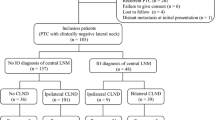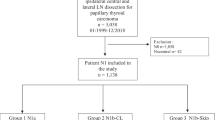Abstract
Background
with the requirement of aggressive follow-up in patients with biochemically incomplete response in patients of papillary ca. thyroid with neck node, a predictor for clinical response would be of great help for better treatment and follow-up planning.
Aim
To determine the utility of lymph-node ratio (central and lateral) as predictors for clinical response post total thyroidectomy and neck dissection.
Materials and methods
51 patients of papillary carcinoma thyroid with neck node were treated with surgery and RAI as per ATA guidelines and were analyzed for a median of 3 years. (Retrospective cohort analysis).
Results
We did response evaluation, correlated clinical response with lymph-node ratios. We found a statistically significant relationship of lymph-node ratio with around a sensitivity and specificity of approximately 90% in predicting the biochemically incomplete response.
Conclusion
we conclude that lateral and central compartment ratios can be used in predicting the occurrence of biochemically incomplete response.
Highlights for review
New idea of evaluating sensitivity and specificity of lymph node ratio in predicting biochemical response.
Well conducted study.
ROC analysis.
Median follow up of 3.1 years with follow ups every 3months.
Lay summary
In patients with papillary carcinoma thyroid with neck node metastasis, the ratio of lymph-nodes harvested to the number of nodes that are actually positive for the cancer can be used successfully in predicting the clinical outcome in these patients post total thyroidectomy and neck dissection. This ratio as an indicator of clinical response can be used to predict those patients who might end up in the category of biochemically incomplete response. So, that they can be treated aggressively with adjuvant RAI and followed-up aggressively.


Similar content being viewed by others
References
Sung H, Ferlay J, Siegel RL, Laversanne M, Soerjomataram I, Jemal A et al (2021) Global Cancer statistics 2020: GLOBOCAN estimates of incidence and Mortality Worldwide for 36 cancers in 185 countries. CA Cancer J Clin 71(3):209–249
Bagcchi S (2016) India launches plan for national cancer screening programme. BMJ 355:i5574
NCDIR [Internet] [cited 2021 Dec 9]. https://www.ncdirindia.org/Area_Cancer.aspx
Nodal metastases in thyroid cancer prognostic implications and management - PMC [Internet]. [cited 2022 May 12]. https://www.ncbi.nlm.nih.gov/pmc/articles/PMC4992997/
Dong W, Horiuchi K, Noguchi E, Okamoto T (2022) Predictive value of metastatic lateral lymph node ratio for recurrence in pathologically lateral lymph node-positive papillary thyroid cancer patients with palpable lymph nodes. Head Neck 44(7):1623–1630
Haugen BR, Alexander EK, Bible KC, Doherty GM, Mandel SJ, Nikiforov YE et al (2016) 2015 American Thyroid Association Management Guidelines for adult patients with thyroid nodules and differentiated thyroid Cancer: the American Thyroid Association Guidelines Task Force on thyroid nodules and differentiated thyroid Cancer. Thyroid 26(1):1–133
Das R, Satya Sai Reddy Gontu G, Das K, Das A, Rahman T, Kumar Das A et al (2022) Validation of ATA guidelines for Indian population: do ATA guidelines have an impact on management of DTC patients in Indian population - A 5 year retrospective cohort analysis. Oral Oncol 132:106016
Ruben R, Pavithran PV, Menon VU, Nair V, Kumar H (2019) Performance of ATA Risk Stratification Systems, response to Therapy, and Outcome in an Indian cohort of differentiated thyroid carcinoma patients: a retrospective study. Eur Thyroid J 8(6):312–318
Smith BD, Oyekunle TO, Thomas SM, Puscas L, Rocke DJ (2020) Association of Lymph Node Ratio with Overall Survival in patients with metastatic papillary thyroid Cancer. JAMA Otolaryngol Neck Surg 146(10):962–964
Schneider DF, Mazeh H, Chen H, Sippel RS (2013) Lymph node ratio predicts recurrence in papillary thyroid Cancer. Oncologist 18(2):157–162
Parvathareddy SK, Siraj AK, Qadri Z, Ahmed SO, DeVera F, Al-Sobhi S et al Lymph node ratio is superior to AJCC N stage for predicting recurrence in papillary thyroid carcinoma. Endocr Connect [Internet]. 2022 Feb 1 [cited 2023 May 17];11(2). https://ec.bioscientifica.com/view/journals/ec/11/2/EC-21-0518.xml
Leboulleux S, Rubino C, Baudin E, Caillou B, Hartl DM, Bidart JM et al (2005) Prognostic factors for persistent or recurrent disease of papillary thyroid carcinoma with Neck Lymph Node metastases and/or Tumor Extension beyond the thyroid Capsule at initial diagnosis. J Clin Endocrinol Metab 90(10):5723–5729
Adam MA, Pura J, Goffredo P, Dinan MA, Reed SD, Scheri RP et al (2015) Presence and Number of Lymph Node Metastases are Associated with compromised survival for patients younger Than Age 45 years with papillary thyroid Cancer. J Clin Oncol 33(21):2370–2375
Funding
Not applicable.
Author information
Authors and Affiliations
Corresponding author
Ethics declarations
Conflict of Interest
Not applicable.
Additional information
Publisher’s Note
Springer Nature remains neutral with regard to jurisdictional claims in published maps and institutional affiliations.
Rights and permissions
Springer Nature or its licensor (e.g. a society or other partner) holds exclusive rights to this article under a publishing agreement with the author(s) or other rightsholder(s); author self-archiving of the accepted manuscript version of this article is solely governed by the terms of such publishing agreement and applicable law.
About this article
Cite this article
Gontu, G.S.S., Das, R., Rahman, T. et al. Utility of Lymph Node Ratio in Predicting Biochemical Incomplete Clinical Response in Patients with Papillary Ca thyroid with Positive Neck Node. Indian J Otolaryngol Head Neck Surg (2024). https://doi.org/10.1007/s12070-024-04777-7
Received:
Accepted:
Published:
DOI: https://doi.org/10.1007/s12070-024-04777-7




